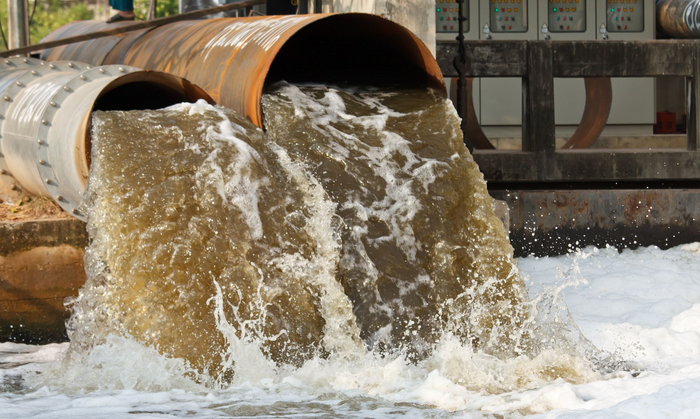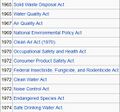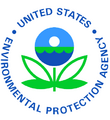Category:Water Pollution: Difference between revisions
Siterunner (talk | contribs) No edit summary |
Siterunner (talk | contribs) No edit summary |
||
| Line 24: | Line 24: | ||
:The evident -- Industrial wastewater; Agricultural runoff; Petrochemicals; Sewage/Human/Animal Waste | |||
:he not-so-evident -- Pathogens; Organic, inorganic and macroscopic contaminants | |||
○ | ○ | ||
* [http://motherboard.vice.com/read/lead-contaminated-drinking-water-is-much-more-prevalent-than-you-think '''Lead Contaminated Drinking Water Is Much More Prevalent Than You Think'''] | * [http://motherboard.vice.com/read/lead-contaminated-drinking-water-is-much-more-prevalent-than-you-think '''Lead Contaminated Drinking Water Is Much More Prevalent Than You Think'''] | ||
Revision as of 21:42, 21 December 2016
Water Pollution / Water Quality -- A Worldwide Health and Environmental Problem
http://en.wikipedia.org/wiki/Water_pollution
... an endemic global problem that requires revision of water resource policy at all levels, international down to individual aquifers and wells
... http://environment.nationalgeographic.com/environment/freshwater/pollution/
- Water pollution is a leading worldwide cause of deaths and diseases
- About 90 percent of the water in the cities of China is polluted (2015) ... As of 2007, half a billion Chinese had no access to safe drinking water
- In a recent national report on water quality in the United States, 45 percent of assessed stream miles, 47% of assessed lake acres, and 32 percent of assessed bays and estuarine square miles were classified as polluted ... http://www.epa.gov/waterdata/national-water-quality-inventory-report-congress
- 'Point source water pollution' (identifiable sources of contamination) and 'Nonpoint source water pollution' (sometimes referred to as 'urban runoff') must be addressed by environmental remediation/cleanup
- Surface water and groundwater contamination are increasingly evident and solutions are necessary
- The evident -- Industrial wastewater; Agricultural runoff; Petrochemicals; Sewage/Human/Animal Waste
- he not-so-evident -- Pathogens; Organic, inorganic and macroscopic contaminants
○
- Lead contaminants are exceptionally damaging when ingested by children
○
http://img.wennermedia.com/620-width/rs-225360-flint-city.jpg
3000+ Cities in the US Have Tested with Lead in the Water Worse than Flint, Michigan
A 2016 US investigative report suggests that recently recorded lead poisoning rates in over 3,000 areas in the U.S. were twice as high when compared to Flint, Michigan, during Flint's drinking water contamination crisis.
The Flint water crisis occurred after the city switched its water supply in 2014. In September 2015, scientific studies showed that around 4-5 percent of children screened there had high blood lead levels.
In the latest investigative report, Reuters found vulnerable neighborhoods where testing showed the highest rates of children with elevated levels of lead in their blood. By relying on data obtained from state health departments and the U.S. Centers for Disease Control and Prevention spanning about a decade, Reuters found about 1,100 communities that had rates of lead blood levels that were at least four times higher than that found in Michigan.
According to the study, pockets within cities such as Baltimore, Cleveland and Philadelphia saw an increase of 40 to 50 percent in blood lead levels in the last decade.
In all, Reuters found 2,606 census tracts, and another 278 zip code areas, with a prevalence of lead poisoning at least twice Flint’s rate. Census tracts have an average of about 4,000 residents apiece, while zip codes average populations of 7,500.
Though requests for data records were placed in all 50 states, due to lack of data or inadequate responses, the Reuters map has limitations: the available data includes roughly 61 percent of the U.S. population in 21 states.
Exposure to lead, a heavy metal neurotoxin, can cause anemia, hypertension, renal impairment, immunotoxicity and toxicity to reproductive organs. Subjection to high levels can also cause coma, convulsions and even death, according to the WHO.
-- Via Raw Story Investigation
○
Subcategories
This category has the following 9 subcategories, out of 9 total.
E
O
P
R
W
Pages in category "Water Pollution"
The following 13 pages are in this category, out of 13 total.
E
Media in category "Water Pollution"
The following 41 files are in this category, out of 41 total.
- 3M lawsuit re forever chemicals - June 2023.png 603 × 600; 357 KB
- About website of The Invading Sea.png 800 × 343; 126 KB
- Amherst-Bottle.gif 364 × 360; 35 KB
- Climate cases on the rise - Nature, Sept 2021.png 800 × 562; 181 KB
- Climate Change Laws - database collaboration.png 640 × 271; 76 KB
- Climate Change Laws of the World - database.PNG 768 × 845; 383 KB
- Climate Change Litigation Databases Climate Law.png 800 × 330; 73 KB
- Congressman george.e.brown.gif 235 × 305; 41 KB
- Disaster scenarios raise the stakes for Colorado River - 1.png 640 × 213; 56 KB
- Disaster scenarios raise the stakes for Colorado River - 2.png 640 × 154; 14 KB
- Dr Volts talks of lawns and their problems.jpg 492 × 376; 49 KB
- Env policy laws US 'the beginning' of env era.jpg 370 × 345; 65 KB
- Environment California - Jerry Brown quote on plastic bags.jpg 480 × 480; 45 KB
- Environmental Justice and Environmental Law.jpg 274 × 668; 108 KB
- Environmental Protection Agency logo.png 380 × 414; 39 KB
- EPA History Xin Liu-2010.pdf ; 2.88 MB
- Estuary in Clearwater on Tampa Bay.jpg 3,584 × 2,016; 1.5 MB
- EWG Tap Water Database.png 640 × 432; 59 KB
- Flooding in South Florida.png 640 × 742; 293 KB
- Florida and climate change denial.png 640 × 192; 46 KB
- George Brown, Sci Com't.jpg 200 × 200; 7 KB
- Invading Seas warning 2024.png 757 × 587; 669 KB
- OaklandWastewater plant.jpg 800 × 399; 125 KB
- Plastic Reduction agr plan.png 800 × 464; 672 KB
- SCOTUS decision on water protection.png 535 × 424; 299 KB
- Sea levels surge along southern US coast.png 640 × 441; 69 KB
- South Florida Floodwaters.png 640 × 449; 251 KB
- The Story of Bottled Water video.png 702 × 395; 97 KB
- US Public Law 95-367.png 732 × 469; 149 KB
- Value the Wetlands - UN Biodiversity Infographic 2023.jpg 633 × 900; 110 KB
- Water Pollution without sewage treatment.png 700 × 419; 602 KB
- Water Risk Projects.jpg 1,140 × 518; 124 KB
- Water shortage 4B people sci report-2016.png 853 × 233; 148 KB
- Water stress by country.png 2,159 × 1,115; 584 KB
- Water stress index map maplecroft.jpg 518 × 303; 123 KB































